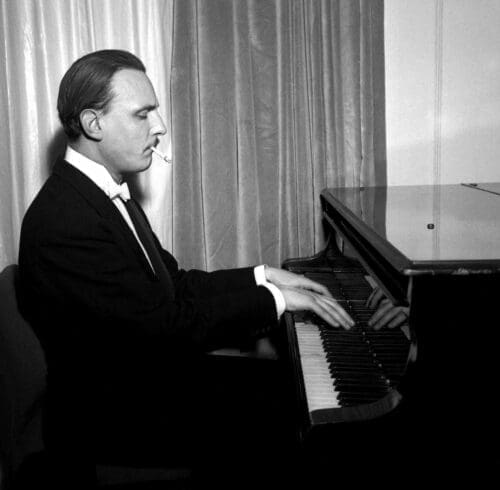Some time ago, I had the pleasure of watching a documentary on Arturo Benedetti Michelangeli (whom, from now on, I will call ABM, as was customary in his day), a pianist so shy that he granted only a couple of brief interviews throughout his life. As a result, the documentary was constructed based more on the testimonies of friends and former students than on the teacher’s voice.

Interpretation as decoding of the score
While discussing ABM’s style, an acquaintance reported ABM’s brief statement about studying new compositions. The content was more or less: “Before I play a new Beethoven sonata in public, I need at least six months because first I have to understand what the composer meant by that music.” Indeed, it is a bizarre statement, considering ABM’s talent and extraordinary technical ability.
However, I am interested in analyzing only one part of the statement, specifically when he states, “…what the composer meant.” Although it might seem unnecessary to discuss, the concept implied in such words is quite insidious for both musicology and the philosophy of music. Indeed, several questions arise, the answers far from trivial.
How far can we go with the “semantic” understanding of music?
First, clarifying a possible interpretation I believe is wrong is good. That is, ABM meant that he needed a lot of time to understand and interpret the musical material in the best possible way. The reason I discard that assumption is precisely related to the figure of ABM. A pianist of his rank and experience would take a technical and stylistic study for granted before a performance and would hardly use the verb “say.” Perhaps he could point out the interpretive difficulties, the somewhat risky choices, and the wanting or not wanting to respect the cultural-historical context that saw the birth of that score. Still, it would make no sense to emphasize the need to understand what ultimately takes the form of a real message.
So we can move to the second question: is it possible to understand what Beethoven wanted to “say” with his music? To try to answer this, it is good to make a premise. A composition of music that is not entirely absolute may contain semantic elements of a linguistic nature, such as a title or dedication. Such information should, in principle, open the door to more informed interpretation.
For example, not everyone knows that Symphony No. 5 has been subtitled as “symphony of fate”; on the contrary, most people know its main motif, Sol-Sol-Mi bem. Thanks to the information in the subtitle, one concluded that that “tolling” so mighty was nothing more than the sound of fate “knocking at the door” of one’s life. In the various movements, Beethoven reuses those four notes in different tonal, rhythmic, and harmonic contexts to underscore an existential journey that starts from the initial disturbing surprise and moves from rebellion and struggle to a state of quiet acceptance (a condition very dear to the composer, who often went out of his way to emphasize the need to pursue the path of joy and serenity).
A posteriori assumptions in interpretation
What is stated, while likely, remains arbitrary, lacking information to test the hypotheses. However, living in an inter-subjective reality based on conventionality, we can take it for granted that Beethoven’s will obeyed the same logical rules that we commonly apply as well and, therefore, that our interpretation is most likely correct (from an objective point of view-since, in the purely subjective sphere, it could be replaced by more imaginative mental processing of the musical material).
But if this reasoning was possible because of the subtitle, what could we say about the sonatas without it? In addition, when any linguistic denotation has a vague character (e.g., “Pastorale” or “Eroica” symphonies always by Beethoven), can we understand the “narrative” intentions in the composer’s mind? The “Pastorale” symphony must evoke a succession of rural scenery, perhaps elicit images of meadows, vegetation, ponds, streams, free-roaming animals, and so on, but what else could it possibly say?
It is now musicologically accepted that music is asemantic. And when you want to denote it as language, you always refer to the emotions aroused, certainly not to philosophical disquisitions or the meticulous description of a field of poppies with a few trees and a couple of horses quietly trotting along. Thus, can we infer that ABM implicitly referred to the emotions Beethoven wished to arouse in listeners?

This possibility is likely but opens the door to an additional problem. Suppose music is inherently capable of arousing emotions. In that case, if the production of the sounds recorded on the score is sufficient to trigger particular emotional reactions, why would one take six months to figure out what the composer wanted to “say”? In other words, if I say “the pen is on the table,” the process of signification based on knowledge of the Italian language (and, of course, of ordinary reality) should not need too much elucubration to reach comprehension.
Conversely, if I were to say “the pen tears oil,” I would be making use of poetic language based on metaphors and other rhetorical figures that might not allow one to arrive at either an unambiguous meaning or even activate an “instant” if not purely literal (and thus, often, meaningless) signification. But this scenario is incompatible with music, as it is firmly based on complex semantics and the descriptive possibility of a reality denoting the most minor details and producing abstractions that can be reused in other contexts through metaphors and metonyms.
Music as an “immediate” communicative form
Therefore, it is reasonable to assume that music falls into the “immediate” communicative forms, whose effects, while remaining partially subjective, do not need to serve complex decoding to manifest themselves in their essence. For example, a piece in C minor, with a slow tempo, long notes, dynamics tending toward “piano,” etc., most likely will not need the subtitle “Funeral March” to arouse a sense of melancholy in the listener. If anything, linguistic information allows one to anticipate what one will hear and, perhaps, be surprised if, at some point, the composer modulates to a major key and switches to a tight rhythm with rapid ascending and crescendo passages. In that case, just like ABM, it would be expected to wonder what was going through the composer’s head!
But while asking this question, can music provide a satisfactory answer? If we were in the presence of a Bach cantata, where first the sorrow of death is described (with tonally minor music and melancholy chants) and then, also suddenly, a Corale in a major key begins with sopranos chanting “Hallelujah,” our surprise would be limited. On the other hand, we know the Gospel story, and we know that Bach, however imaginative and original, would never have taken the trouble to mock death with a brilliant jig and then assign the basses the resurrection hymn while the horns and basso continuo mumble a counterpoint with mournful, compassed features.
But all this is possible by the presence of a text, a linguistic narrative of a story. Music, willingly or unwillingly, will necessarily have to subordinate itself to the semantically dominant elements unless it renounces all structured (albeit asemantic) communicative aspirations altogether and takes refuge, for example, in dodecaphony to give rise to an autonomous and, in many ways, deliberately incapable of communicating by following conventional paths.
Going back to the original question, is it reasonable to assume that ABM wished to penetrate Beethoven’s mind almost like a psychic in front of an old portrait? It is much more reasonable to assume that he, instead, wanted to find some form of “resonance” between his feelings and what he projected in his mental image of a conflicted composer, perpetually striving for happiness but continually thwarted by life events (not least, his early deafness).
The proper role of the interpreter
After all, isn’t that precisely the job of an interpreter? Wasn’t ABM to continue the creative process started by Beethoven by having his music unfold in the present time? If one accepts this hypothesis, “trying to understand what he meant” results in a process of internalization that does not claim semantic extension. At the same time, while accepting the immediacy of musical perception, he is not content to reproduce the notes as they are printed on the score but, on the contrary, wishes to become a composer himself to “color” with his palette those feelings and affections that music (even reproduced by a synthesizer) should normally arouse.
In this way, not only the formal elements (i.e., time, tone, rhythm, etc.) that define the contours of the “message” but also those nuances that, like the patina that forms on bronze, have the gift of uniqueness. But such uniqueness cannot result from an improvised performance. On the contrary, it needs a reading that takes license to “make music say” what music does not and never will say. Only in this way can the work of musical art be kept alive and given back to the audience of any age: not by playing, but rather, by creating at a given moment in history what has already been, definitely but never wholly, created at any time in the past.
Brief biographical note on Arturo Benedetti Michelangeli
Arturo Benedetti Michelangeli was an acclaimed Italian pianist known for his impeccable technique and profound interpretations of the classical piano repertoire. Born on January 5, 1920, in Brescia, Italy, Michelangeli showed exceptional musical talent from an early age. He studied at the Milan Conservatory and won the prestigious Geneva International Piano Competition in 1936.
Throughout his career, Michelangeli was revered for his brilliant interpretations of works by composers such as Bach, Beethoven, Debussy, and Ravel. His meticulous approach to music and dedication to perfection earned him a reputation as one of the greatest pianists of the 20th century. Despite his perfectionism and occasional performance cancellations, Michelangeli’s concerts were highly anticipated by audiences worldwide.
Michelangeli’s recordings inspire pianists and music lovers, showcasing his unparalleled artistry and technical mastery. His legacy lives on through his timeless interpretations, solidifying his place in the pantheon of classical music legends. Arturo Benedetti Michelangeli died on June 12, 1995, leaving a rich musical legacy that fascinates audiences today.
If you like this post, you can always donate to support my activity! One coffee is enough! And don’t forget to subscribe to my weekly newsletter!

